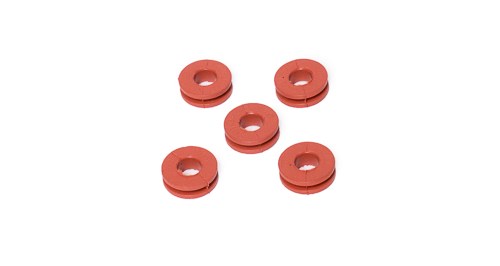The Shore Hardness scale is a universal scale for measuring and communicating the hardness of a material, including rubbers and plastics. Since hardness is generally a subjective measurement, the Shore scale was created to give everyone a common point of reference when discussing products and applications.
How does the Shore Hardness scale work?
The Shore scales are used to measure the hardness of a number of materials, including rubbers, semi-rigid plastics, hard plastics and thermoplastic elastomers. Metal materials are not measured on the Shore scale and instead use the Rockwell Hardness tests as a universal measurement.
Pictured: A Shore Durometer device testing a material. 1 indicates the Shore Durometer itself and 2 indicates the materials being tested.
Measuring material hardness is so vast, that there are several different Shore scales in use, including Shore OO, Shore A, Shore D and Shore H. All Shore scales range from 1-100. Harder materials are assigned higher numbers on the scale. Hardness is measured using a tool called a durometer.
It is important to note that there is a good amount of overlap among the Shore scales. For example, a material rated Shore 95A is equivalent to a Shore 45D. This can be seen in the conversion chart below:
Why are there so many different Shore scales?
Measuring durometer is not an exact science. Durometer is measured by placing a probe specific to each scale on the material and creating an indent. If the indent is more than 0.1”, the durometer is 0 on that scale. If the indent does not appear at all, then the durometer is 100 on that scale. If an extreme of 0 or 100 is measured, a different probe must be used to measure durometer on the next harder (or less hard) scale.
Readings are most accurate in the middle of each scale with accuracy falling off the closer you get to the extremes of 1 and 100. Using the example above, the Shore D measurement of Shore 45D would be more accurate than Shore 95A, since it’s closer to the middle of the Shore D scale.
What’s the difference between Shore A and Shore D?
The Shore A scale is commonly used for softer materials while Shore D is used to measure more rigid materials. Both scales are used in our industry, but Shore D is usually reserved for extremely rigid products like hard hats or golf balls. Most rubber products are measured on the Shore A scale.
What are some common rubber products measured with Shore A?
 Pictured: Custom silicone grommets
Pictured: Custom silicone grommets
At Custom Rubber Corp., we generally work within the Shore A scale. Examples of products we create include:
- Silicone grommets, soft enough to work with a large range of wires
- Car wash dryer parts soft enough to avoid scraping cars
- Stiff, specialty insultated electrial connection covers
Generally, the materials we work with fall in the middle range on the Shore A scale, from A50 to A70. Not too soft, not too hard!
Who invented the Shore scale?
Albert Ferdinand Shore was an American metallurgist, meaning he worked as a materials scientist specializing in metals. He invented the first durometer, a tool used to measure material hardness, in 1914. He went on to create the Shore scale in the 1920s before his death in 1936 at age 59. (If you think the science of measuring material hardness is confusing, he’s the guy to blame.)
4 Additional Considerations for the Shore Hardness Test
Let’s take a minute to clear up a few common misconceptions we see around measuring the hardness of rubber materials. These may surprise you.
1. ) Shore Hardness is not an exact measurement
The biggest misconception we see around the Shore Hardness test is the assumption that it’s an exact measurement. In reality, the final measurement is typically plus or minus five points on the durometer scale, which is a fairly large range. It can be very difficult to get consistent results.
To remedy this, rubber manufacturers can conduct a Gage Repeatability & Reproducibility (Gage R&R). Three different people will use the same gauge to measure the hardness of several different parts. The results inevitably differ between all three people, and are averaged out to determine hardness at plus or minus five points. It’s not perfect, but it’s the best solution we have.
2. ) Test specimens must meet certain specifications.
Accuracy is even less exact when measuring the hardness of a part that doesn’t match the ASTM test specimen guidelines, which is at least ¼” thick and flat. The test point must also be at least half an inch from the edge.
.png)
It can be impossible to measure a small, thin rubber piece like a tiny gasket or seal that falls outside these guidelines. Instead, manufacturers often measure durometer with a set of test samples molded separately in a standard test mold.
3. ) Hardness varies with the curing process - we use this to our advantage
Rubber often starts as a low-viscosity material that cures over a period of time. Uncured material tests extremely low on the Shore A scale. Midway through curing, it may end up at 20A or 30A. It will not hit its full durometer until curing has finished and all chemical reactions are complete.
Because durometer is a quick, non-destructive test, we often use it to confirm a part’s “state of cure,” to ensure it has been fully vulcanized. It’s one of our final quality assurance practices prior to shipping. It’s not exact, but our experience has shown it to be an effective last check.
4. ) Hardness can change even after vulcanization
As native Cleveland, Ohioans, we know a thing or two about cold weather. We once shipped out parts and received a call from the customer that the durometer was off. However, the parts were measured right off the truck after traveling hours in 15-degree weather and the chill had hardened the materials.

The same would be true for parts stored in a hot warehouse in the summer. The ASTM test specification that outlines the test specimen size and thickness also defines conditioning and testing temperature at 23 ± 2 °C. That’s why we advise clients to place the samples in a temperature-controlled room for a few hours before measuring again.
All this to say: Hardness is finicky and not exact. It may have several overlapping scales, and variable accuracy, but in the rubber industry, the Shore A and Shore D Hardness scales remain the best tools we have to ensure parts are high-quality, uniform and function as expected.
Have a question? Our experts are standing by. Click here to request a quote or ask Custom Rubber Corp. staff about rubber material hardness.